|
FAQs about Marine Snail
Identification 25
Related Articles: Gastropods, Sea Slugs, Mollusks, Abalone,
Related FAQs: Snail ID
1, Snail ID 2, Snail ID 3, Snail
ID 4, Snail ID 5, Snail ID 6, Snail
ID 7, Snail ID 8, Snail ID 9, Snail ID
10, Snail ID 11, Snail ID 12, Snail
ID 13, Snail ID 14, Snail ID 15, Snail ID
16, Snail ID 17, Snail ID 18, Snail ID
19, Snail ID 20, Snail ID 21, Snail
ID 22, Snail ID 23, Snail ID 24, Snail
ID 26, & Marine Snails 1,
Marine Snails 2, Marine Snails 3, Invertebrate ID, Snail Behavior, Snail Selection, Snail Compatibility, Snail Systems, Snail Feeding, Snail Disease, Snail Reproduction, Mollusks, Sea
Slugs, Abalone,
|
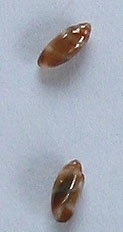
|
|
Nassarius snail ID and a quick <fdg.>
question 9/5.5/11
Hello
I've had this snail for a while in my tank and have had no
problem with it but I'm wondering if it really is what it was
sold to me as or not. I was told it was a Super Tongan Nassarius,
but I've never seen one that looks like this and I'm
hoping it's not a whelk (which I've heard are not reef
safe).
<Mmm, no... tis an Ilyanassa/Nassarius sp.>
My next question is, assuming that it's an ok snail, should I
be supplementing feeding?
<Not likely, no>
It has been with me for about 3 months and I have not so far, but
this is a Nano tank so I'm concerned it might not be getting
enough food and that I might be starving the poor thing. It
doesn't come out very often except feeding time (and even
then sometimes it doesn't bother coming out), which I believe
to be typical of Nassarius. I do have detritus in the tank in
some spots (like most tanks) and have heard that Nassarius target
it, yet I never see it come out to eat it. Any idea why? Thanks!
:-)
<Please read here:
http://wetwebmedia.com/MolluscPIX/Gastropods/Prosobranch%20PIX/Nassariids/NassariusF1.htm
Bob Fenner>
|
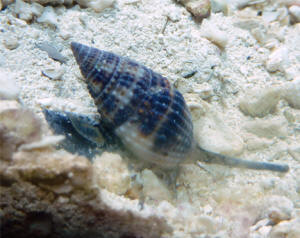 |
|
Another Live Rock Hitchhiker ID
5/15/11
Dear Crew,
<Joe>
Thanks so much for your time! Just a quick ID today.
<Ok>
I noticed several of these organisms upon viewing my reef this
evening. The tank has been set up for several years and has seen
flatworms, bristle worms, and Aiptasia among other pests, all
which have been easily managed thanks to WWM!
I've never seen anything like these and they have seemed to
have just popped up.
Nothing new has been added to the tank in 7 or 8 months.
They seem to have a mucus foot, and tiny shell, and two clearly
identifiable antennae. They look like baby snails. The one on the
top is actually two that are in close proximity. I'm sorry
about the pic quality- these boogers are tiny, perhaps 1 mm or
less.
I've not read much about snail reproduction evolving beyond
the egg stage in home marine aquaria and therefore doubt
that's what these guys are.
Any ideas? Friend or foe?
<Are these actually moving? To me they look
like small Syconoid sponges.
Please see the Net, WWM re. Bob Fenner>
Thanks!!
Joe
|
|
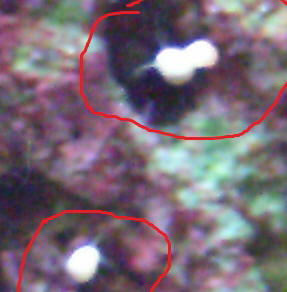
|
|
Re: Another Live Rock Hitchhiker ID
5/15/11
Thank you Bob!
<Welcome Joe>
I really appreciate your time! This is a busy month for you!
<Don't know what I'd do if I had a real job!>
These are definitely moving. The pic was taken
of the ones that are crawling on the aquarium glass. I did some
posting on our local forum and a couple of folks thought they
look like Collonista snails, which they indeed
do.
<Possible>
In any event, I doubt that they are any harm to the reef.
<As long as not too many in number...>
Thank you again, enjoy yourself, and as always, stay safe!
Joe
<Thank you. Cheers, BobF>
|
|
Snail ID Request -- Whelklets in My Nano? Yes!
3/30/11
Hello,
<Hello Ken, Lynn here today.>
I've recently discovered two small snails in my 14 gal. Nano
reef tank that look like they might be bad guys.
<You'd be right!>
After searching a variety of Web sites, including the generous
amount of wonderful info on WWM, my eyes have crossed and
I've decided to appeal to the experts. What might they
be?
<They're whelks of some sort (family Buccinidae, subfamily
Pisaniinae). Do you know where they originated? If it was from
around Florida, they're most likely one of the following
species: Gemophos tinctus (the Tinted or Painted Cantharus),
Gemophos auritulus (the Gaudy Cantharus), or something like
Engina turbinella (the White-spotted Engina/Spotted Lesser
Whelk). The Gemophos species both have mottled shells of varying
color and the same spotted/mottled soft tissue I see in one of
your individuals. Unfortunately, I can't find a good photo of
the soft tissue of E. turbinella for comparison. Beyond that, the
ID is complicated by the degree to which each species can vary in
color, pattern, and shell structure. For example, Engina
turbinella can appear heavily spotted or thinly banded. I'd
need detailed, close-up photos (especially of the lip
area/aperture), and the location of origin, in order to proceed
further.>
Will they get huge, or stay small
<If they're one of the Gemophos species, they can reach a
maximum shell length of ~1.25'/32mm (G. tinctus) to
~1.4'/35mm (G. auritulus). Engina turbinella, on the other
hand, tops out at a diminutive .6'/16mm.>
..and cute?
<Definitely! I think they're neat-looking little snails.
It's just a shame they're not good candidates for a mixed
reef system.>
Are they killers, or star Hoovers for the clean-up crew?
<Heeeee! These snails have the potential to be star Hoovers
*of* the clean-up crew! They're opportunistic, carnivorous
predators and scavengers. Unfortunately, I don't have any
details regarding the specific diet of Gemophos auritulus or
Engina turbinella, but I can tell you that although Gemophos
tinctus has a preference for sessile invertebrates, it will also
prey on other snails and bivalves. Trust me, I've seen it
first-hand! The bottom line is that I wouldn't trust any of
these species around other snails. For more information/photos on
these species, please see the following links:
Gemophos tinctus: FAQ titled 'Snail ID: Predatory/Scavenging
Whelk -- 2/12/10' (refer to links within as well):
http://www.wetwebmedia.com/WhelkF.htm?h=
http://z14.invisionfree.com/Conchologist_Forum/index.php?showtopic=1710
Gemophos auritulus: In situ: http://www.jaxshells.org/2295anne.htm
http://z14.invisionfree.com/Conchologist_Forum/index.php?showtopic=1711
http://www.gastropods.com/7/Shell_1927.shtml
>
Engina turbinella: http://www.gastropods.com/4/Shell_1924.shtml
http://z14.invisionfree.com/Conchologist_Forum/index.php?showtopic=1908
>
I've attached two pictures showing tops and bottoms.
<Thank you! Good photos make all the difference when it comes
to ID work.>
The shell of the larger snail is about 1/4 inch long. I currently
have them quarantined until I can figure out if they are safe to
keep. Please advise: should they stay, or should they go?
<They should go 'or as Arnold would say 'Hasta
la vista, baby'. You could always set them up in a separate
Nano system if desired. Just offer meaty bits of marine origin
(fish, clam, squid, etc.) or possibly sinking pellets designed
for shrimps, crabs, and the like.>
Thanks for your help, and for all the great work you do to
maintain this amazing Web site!
<You're very welcome and thank you!>
Ken
<Take care, Lynn Z>
|
|
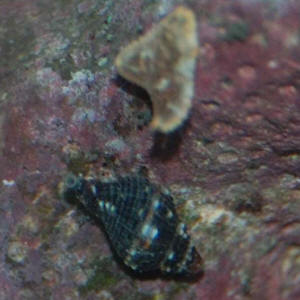 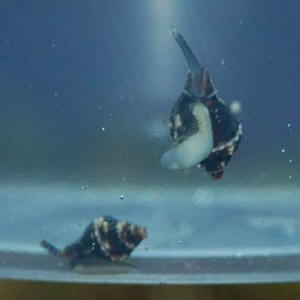
|
|
Snail Problem. Need Help Identifying and Removing --
3/6/11
Dear Bob & Group,
<Hello Pritesh, Lynn here today.>
I have this big problem of snails in my Saltwater Aquarium; it
looks more like a snail tank and less than a fish tank. :D
It's a FOWLR type of setup.
<What size tank?>
I have 3 Fish in the tank as of now. A pair of Nemo and a
Pakistani Butterfly Fish.
So now about my problem. I have a major outbreak of snails in my
tank. I am attaching few photos with this email that should help
you identify the type of snail.
<Unfortunately, I'd need a bit more information (size,
where the snails originated) and close-up, detailed photos in
order to supply an ID. I can tell you though that whatever it is
appears to be some sort of algal grazer.>
I want to get rid of these snails. There should be more than 500
small snails in my tank now.
<Yikes!>
Please suggest me some fish which would eat these snails (should
not bother existing fishes) or some way of getting rid of
them.
<I would opt for thinning them out a bit, via manual removal,
and keeping the remainder on hand as part of your clean-up crew.
(Bob, do you have any input here re: possible
predators?)<<<Not w/o knowing more re the size of tank,
other livestock. RMF>>
Resized the images as you told.
Thanks
<You're very welcome.>
Regards
Pritesh
<Take care, Lynn Z>
|
|
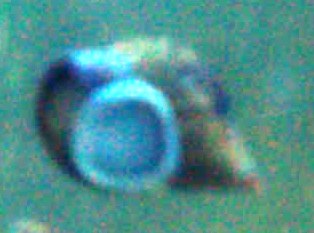
|
Predatory Snail Problem --
1/30/11
Hi,
<Hi there, Lynn here today.>
I am having a problem with some predatory snails in my marine tank.
<Uh-oh>
There are two types: one looks like a dove snail, but when it gets near
to a dove snail it chases it. When it is close it looks to stab it
causing it to fall off the tank glass. It seems to have recovered but
I'm finding a lot of empty dove snail shells.
<There are a number of possibilities as to the culprit, but it
sounds like some sort of predatory Whelk or possibly a Murex. In order
to narrow things further, I'd need a couple of photos and a bit
more information (where the snail originated, size, along with any
other observations not visible in the photos). If possible, when taking
the photos, try to get two shots from above, each showing the length of
the shell (at least one showing the side with the opening). This is a
whole lot easier to do if you can remove the snail to a bowl of SW. If
you're unable to do this, just do the best you can with a photo or
two of the snail while it's still in the tank.>
The second is white in colour and hides in the gravel. It is larger,
about 1" long, and I have only ever seen it eating mussel meat and
a fish I lost after being stung by one of my anemones. Is this likely
to be predatory or just a scavenger?
<It could be both. Again, there are numerous possibilities. You
could have a scavenging Nassariid (family Nassariidae -- includes
Nassarius spp. as well as the often light-colored Bullia spp.), some
sort of Olive snail (family Olividae), or something else entirely. If
possible, please do send along some photos and a bit more information.
Hopefully the combination will enable me to give you a better idea as
to what you're dealing with. By the way, if you're unable to
send photos, and decide to leave the snail in place, be sure to keep it
well fed with meaty bits of marine origin such as fish, clam, shrimp,
squid, etc., and keep an eye out for signs of predation.>
Is there a way I can remove the snails that are feeding on the dove
snails?
<I'd opt for physical removal on sight. I'd also recommend
periodic checks at night after the lights have been out for a
bit.>
Thanks in advance
<You're very welcome.>
A Reid
<Take care, Lynn Z>
|
Collonista pic 1/21/11
Hi WWM crew...thought I'd share my first non-fuzzy pic of a
Collonista in my tank. He was nice enough to perch on an
outcropping of LR that is very close to the front glass. I
noticed him because he was 'blowing smoke' - sperm cloud
I presume. That's when I realized he was probably not a baby
Turbo, but a mature Collonista (he's about 1/4 inch
diameter).
Thanks for all your invaluable help and information!
-Tommy
<Thank you for sharing Tommy! Bob Fenner>
|
|
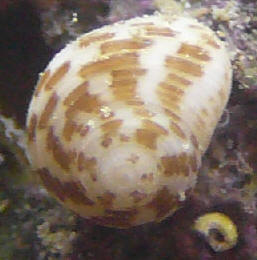
|
|
Mystery Mollusk 1/17/11
Would love it if anyone can point me in the right direction on an
ID for a hitchhiker that came in with one of my Zoa colonies. I
think it's a mollusk...I've had trouble putting together
a good enough description of
this thing to generate a proper search string. I've scoured
photo ID pages of mollusks and gastropods, but I don't know
if I'm even on the right trail.
<Mmm, I think I see what you're referring to... have
cropped the middle image you sent along... see the Daily FAQs
re... This is a Vermetid Snail:
http://wetwebmedia.com/MolluscPIX/Gastropods/Prosobranch%20PIX/Vermetids/tubesnailf.htm
This little guy is only about 2-3mm in diameter. He is embedded
in a rock that houses a Zoa colony, and seems to be permanently
attached. Hasn't changed location since I got the rock/colony
about 5 months ago. He has a radial disc-shaped top shell that is
reddish-brown and looks like an operculum of some
kind with a hole or depression in the center, and he can withdraw
and seal himself shut with it.
<Good clues, description>
When he pops open, there's a soft body that looks sort of
like a tiny snail, and I count 4 tentacles, 2 very short and 2
longer, one of the longer ones about 3 times as long as the
other, stretching to about 5 mm.
His behavior is the most peculiar thing about him, and what made
me notice him to begin with. He seems to feed by spooling out a
long strand of mucus as a fishing line, and then slowly reeling
it back in a mm or so at a time.
<Yes>
At first I thought it was a secretion from the Zoas, but it is
just a single thread that traces back to this guy, and he does
consume it as he reels it in. In fact, sometimes he
'catches' one of the Zoa polyps and bends it back up
towards him, but he doesn't seem to do any damage, it just
gets released once he pulls the thread back in.
<Not problematical>
The hole in the shell had me thinking keyhole limpet from some
pics I saw, but it sounds like those are bigger and more mobile
and snail-like. I then found a description of Limacina helicina
that described what sounded like a similar mucus-fishing
behavior, and pics look a little similar (though transparent),
but
that sounds like it's a free-floating snail or jellyfish of
some sort (http://jellieszone.com/limacina.htm). I also wondered
if it could be some kind of barnacle, but haven't seen any
mention of these in my searches.
It's proven difficult to get a clear photo of this guy due to
his size, but I've attached a few small ones that are the
best I've been able to do. Any help you can provide is
greatly appreciated!
Thanks,
-Tommy
San Francisco
<Do see my pix on the citation and the linked files (above) re
this family. Bob Fenner>
|
|
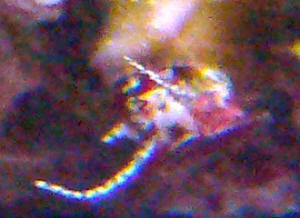
|
|
Re: Mystery Mollusk
That's the critter! Thanks very much, good to know he's
not a threat.
More reading to do now...
-T
<Ahh! B>
|
|
help id this hitchhiker 1/6/11
Hi guys and gals at WetWebMedia
<Howdy Sujan>
Greetings from South Africa.
<And back at you from (today) sunny Southern Cal.>
As always thank you for your past help in identifying the various
critters I have found on live rock.
Can you please help identify this creature which appears to be
some sort of slug or Nudibranch? I am hoping it is not
harmful.
<Mmm, is a gastropod... likely a Limpet... see the genus
Scutus on the Net. Not generally harmful>
It's about 1.5 inches and moves quite quickly. I have mainly
Indonesian live rock in my tank and the only recent addition has
been some Zoanthids and a pagoda coral.
I am thinking that it probably came into my tank with the more
recent additions.
<Likely so>
thank you very much for your help.
regards,
Sujan.
<Welcome! Bob Fenner>
|
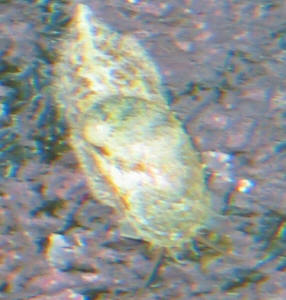 |
Re: help id this hitchhiker
1/6/11
thanks, Bob :) You are really quick to answer. Almost like a doctor
that does house calls... only much, much better.
<Heeee! At least no gagging tongue depressors!>
All the best for the new year :)
regards
Sujan
<And you my friend. BobF> |
|
Possible ID please? snail and crab
11/13/10
Greetings to you and the crew,
<Richard>
Once again I find myself relying on your expertise to sort out
the miss-information I've gained through my research
attempts.
The snail I have come to believe could be a whelk of some sort...
but have also researched that since this shell does not display a
body two times longer then the spire, so it isn't.
<Mmm, give a read here: http://reefkeeping.com/issues/2005-11/rs/index.php
Unfortunately, I can not confirm where the little guy is from.
All the live rock is about a year or more old and was touted as a
combo of Fiji and Florida, with any frag/coral spending 8 to 10
weeks in isolation minimum... so I actually have no idea how long
it has been in there. I have him in a container with a small
piece of krill mash hopeful to observe it eat as I have read that
whelks can/do not eat algae - but apparently being captured has
put off his appetite. Could you possibly confirm what he is
please?
<Likely a Conch...
http://wetwebmedia.com/MolluscPIX/Gastropods/Prosobranch%20PIX/Conchs%20Strombids/ConchF1.htm>
On a side note - could it be the reason for the die-off on the
Monti?
<Mmm, not at all likely>
The crab was found on a piece of Haitian rock (still in
isolation) and I am thinking Mithrax...
<The genus? Nah>
'cept I can't find any as fuzzy or grainy as he is. Of
course, there isn't a wealth of 'identified' crab
pics out there either:) Another description leans towards
a Black-Finger Crab, but they generally do not show/have fuzz.
Presently he resides in a 3L Nano cube (no... not a typo) with
chelto (spelling?) left in at all times, Nori, veg and meat
flakes, and krill. I can't verify which he is eating. Again I
ask... Can you ID please?
<Not from this pic, no. Bob Fenner>
Richard
|
|
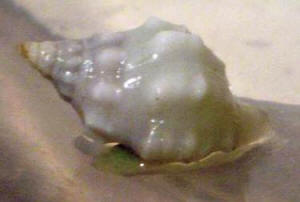 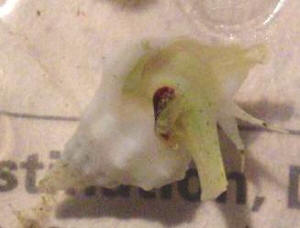 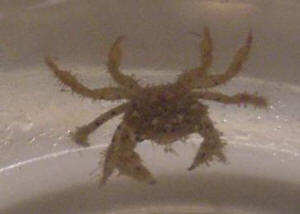
|
|
Need help id snail, need better pix
10/27/10
hey guys,
<And gals>
I am having this problem in my SALTWATER AQUARIUM. I am having a
snail outbreak and I am unable to identify which snails are
they.
daily I have to remove at least 20 of these snails.
I am attaching a photo of the snail. the photo is not that clear
cause its taken from a cell phone cam.
<Too blurry to be of use. Peruse here:
http://wetwebmedia.com/snailidfaqs.htm
and the linked files above. Bob Fenner>
regards
|
|
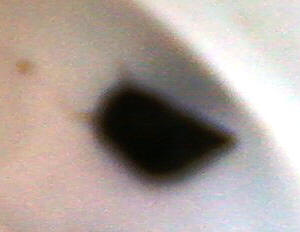
|
|
R2: Nassarius Snail Question/Amphiprion Cross-breeding
(and now, snail ID) - 09/01/10
Hi Eric,
<<Hiya Chris>>
I have attached a photo of the snails that have been showing up
in my aquarium - in the various sizes that I have noticed.
<<Ah yes'¦ These look to be a species of Nerite,
or maybe a Collonista species (take a look at the operculum
covering the shell opening--Collonista spp. have a prominent
'pit' in the center). Either way, nothing to be concerned
with>>
Just a few questions - does it at all look like any of the conch
eggs could have survived?
<<No--these are not Conchs>>
If not, is this a snail that you readily recognize and under the
circumstances would you still consider it harmless or even
beneficial?
<<Yes (well, as stated at least) and yes>>
Thanks again to all for the expert direction!
Chris K
<<Always a pleasure to share, Chris'¦ Eric
Russell>>
|
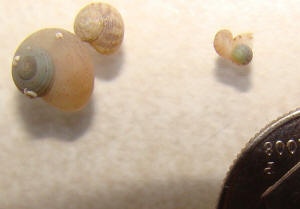 |
|
Snail Overpopulation: Likely Juvenile Ceriths -
8/26/10
Hello once again WWM crew.
<Hello Miguel, Lynn here today.>
Have you ever had one of those sleepless nights and you just
wondered what was going on in your tank and you take a peek?
<Oh yes.>
Well I had one of those a couple of nights ago and decided to
check in on my reef tank. I'm glad I did because I noticed a
Teddy bear crab munching away on a lord coral frag,
<Yikes!>
(I was fortunate enough to just pick up the frag and dump the
crab into my refugium)
<You were very lucky indeed to have been able to catch it that
easily.>
.. but I also noticed hundreds of small white snails all over the
LR. I had seen a few of these small snails during the daytime and
I just thought they were baby Cerith snails.
<They could be either juveniles or some other species
entirely. Chances are good that they're harmless. There are
quite a few small, white(-ish), beneficial herbivores. I'd
need to see a couple of high resolution, close-up shots (one
taken from above the snail, the other showing the opening) to
have much of a chance at an ID. >
I had also seen what I thought were immature Cerith snails which
were black with a white tip. I started looking for an I.D and
along the way someone mentioned pyramid snails.
<Yikes, you don't want those. Thankfully, I doubt
that's what you have. Pyrams are typically very small (less
than 5mm), and white to a light brown/tan in color. They
don't have the strongly demarcated white/dark brown/black
shells like I see in your photos. Please see the following link
for more information related to distinguishing Pyrams from other
harmless snails such as Rissoids:
http://www.reefland.com/articles/rho/identify-this-rissoid-and-pyramidellid-snails
>
Do Ceriths start out white? Or do they start with the same colors
as the adults?
<To be honest, I'm not sure. I haven't seen any white
juveniles (of normally dark-shelled species), but that
doesn't mean they're not out there. >
Enclosed are a few pictures. The first one is comparing a Cerith
with the largest of what I'm calling the "immature
Cerith".
<I'm pretty sure that's a Cerith of some sort.
It's a shame the large individual's shell is covered with
so much coralline. There's no way I can compare the surface
texture of the two.>
The second one is of two sizes of the "immature
Cerith?"
<This one threw me for a bit because the shells appear
stockier than a typical Cerith. Thankfully, they look enough like
the snail in photo 1 that I think it's just an issue of
viewing angle. If I hadn't seen that first individual, I
would have looked into the possibility of a Nassarius species or
perhaps a whelk in the genus Pollia, Gemophos, or Cantharus. I
don't think it's any of those, though. I don't see
any long siphons (typical of whelks and Nassarius spp.) and the
combination of surface texture, color, and proportion isn't
quite right. The more I look at all of the individuals (excluding
the white ones), the more I think that what you're seeing are
juvenile Ceriths. If I had to guess, I'd say they're
probably Cerithium lutosum (aka the Dwarf Variable Cerith), due
to shell texture, whitish tips, and the fact that they reproduce
well in aquaria. Naturally, I have to throw in the caveat that
there are many Cerithium spp. out there, along with several
closely related genera, so the possibilities are many. The bottom
line is that I don't think you have anything to worry about.
>
..and the last one there two of the small white snails (9 and 3
o'clock)
<Again, these could be very young snails or something else
entirely. Whatever they are, chances are good that they're
harmless.>
..and two of the black/white snails (11 and 6 o'clock). Do I
need to be concerned about these snails if they are not
Cerith?
<I wouldn't be, not unless you're noticing
damage/injury to livestock.>
And if they are not Cerith, any idea as to what they are?
<There are many possibilities. I'd need some good photos
and a bit more information (how big they are and where they
originated, if possible). Please see the following links for
comparison:
Cerithium lutosum: http://www.gastropods.com/0/Shell_2560.shtml
More Ceriths:
http://www.gastropods.com/Taxon_pages/TN_Family_CERITHIIDAE_CERITHIINAE.shtml
Gemophos, Pollia, Cantharus, for comparison:
http://www.gastropods.com/Taxon_pages/TN_Family_BUCCINIDAE_PISANIINAE.shtml
>
As always thank you for your help in all these fishy matters,
<You're very welcome.>
Miguel Miguel
<Take care, Lynn Z>
|
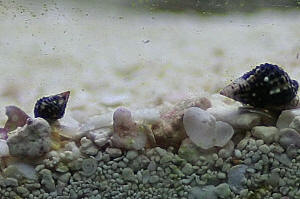 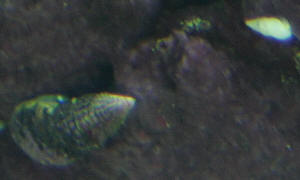 |
|
Re: Snail Overpopulation: Likely Juvenile Ceriths -
8/28/10
<Hello Miguel.>
Thank you for the reply Lynn Z.
<You're very welcome.>
It is time to get the macro lens out and take better pictures and
forward them to you.
<Sounds good.>
As to the origins of these snails, the stockier black and white
snails (and the small white snails) started appearing after I
added some Chaeto to the refugium.
<Thanks, all information is useful.>
I personally did not add them to the main tank but they are there
now.
<You purchased Ceriths though, right? If so, do you know the
species, or even the common, name? If not, be sure to include a
photo of one (whichever has the least amount of coralline
covering the shell).>
I imagine they got pumped into the main tank from the refugium.
The mouth piece of the stockier, black and white snails are
identical to the Cerith, no long proboscis.
<That's good to know, thanks.>
Anyhow, I will try to get higher resolution pictures to you to
try to figure out what they are. BTW, so far I have not seen the
small white snails bother the corals...yet.
<I doubt you will. If they were coral predators (like
Epitonium spp./Wendletraps), they'd be all over their coral
of choice and if they were Pyrams, they'd be after your
snails (especially Astraea/Lithopoma spp. or clams). Honestly, I
think these snails are nothing to worry about, but I'm more
than happy to take a look at any photos just to make
sure!>
Thank you for your help,
<It's a pleasure.>
Miguel
<Take care, Lynn>
|
|
Unknown Critter ID? Snail - 8/23/10
<Hello Penny, Lynn here this afternoon.>
Got another hitchhiker snail that I can't ID. Good or bad
guy?
<Hmmm, I'd love to help, but I need a bit more information
and a more detailed/larger/higher resolution photo. By any
chance, do you know what part of the world the snails came from?
Did they hitchhike in on a particular coral and if so, what type?
Also, what's the size? Any and all information you can supply
will be helpful. Right now, I can't tell if what you have is
some sort of Olive (family Olividae), a juvenile Cowry (family
Cypraeidae) or something else entirely. Whatever it is, it's
pretty but I'm betting that you'd like a bit more
information than that!>
Thanks in advance for any help!
<Unfortunately, I can't offer much now, but hopefully that
will change with the above info and another photo!>
Penny Harkins
<Take care, Lynn Zurik>
AquaCorals - Saltwater Reef Aquariums
www.AquaCorals.com
|
 |
|
|

